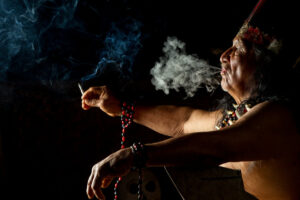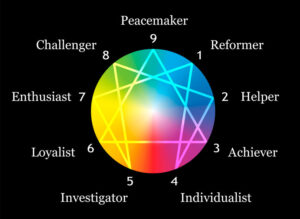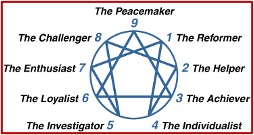Shamanistic Healing with Ayahuasca

Ayahuasca had (has?) a Hollywood connection. Celebrities like Jim Carrey, Lindsay Lohan, Chelsea Handler and others took the ayahuasca train for reasons as varied as personal enlightenment and telepathic experience. Celebrity interest in ayahuasca dates back to William Burroughs, who said the effects of yage (ayahuasca) were indescribable. “It is the most powerful drug I have ever experienced. That is, it produces the most complete derangement of the senses.”
The above quote is found in “The Yagé Aesthetic of William Burroughs,” the PhD Thesis of Joanna Harrop. She noted how The Yage Letters, published ten years after his own search for ayahuasca, did not include these comments. Perhaps Burroughs telepathically anticipated the actions that would later classify ayahuasca’s psychedelic ingredient, DMT (dimethyltryptamine), as a Schedule I controlled substance and intentionally left out those comments. Harrop noted that in his correspondence Burroughs seems to think of yage was a secret Cold War weapon. He said, “I know the Russians are working on it, and I think U.S. also. Russians are trying to produce ‘automatic obedience,’ have imported vast quantities of Yage for experiments on slave labor.”
While some follow Burroughs in his journey to the South American rainforests in search of their ayahuasca ritual, others simply fly a shaman in to L.A. from the Amazon River region to perform an ayahuasca ceremony. Because DMT is illegal in the U.S. these ceremonies are “invite-only.” You have to be vetted beforehand and show you’re serious about having the experience. In 2015, it was said: “On any given L.A. night, there are 50 to 100 circles being conducted.”
Scientific Studies of Ayahuasca for Healing
Yet there are also scientific studies being done to determine if ayahuasca can treat or heal depression, anxiety, PTSD and alcohol abuse. Scientists are also exploring how DMT alters the user’s waking brain-wave patterns, producing an experience that has been described as “dreaming while awake.” A study published in Scientific Reports by Timmermann et al found that immersion in the DMT state led to marked decreases in the user’s brain-wave patterns. Ars Technica said the subjects were fitted with EEG caps and electrodes to monitor their brain activity while being given an infusion of DMT. “The team found that the DMT caused a marked drop in alpha waves, a mark of wakefulness, along with a corresponding brief increase in theta brain wives, indicative of a dream state.”
These researchers also found there was more chaotic brain activity in subjects who were under the influence of DMT. They speculated this may explain why ayahuasca users report more vivid visual effects and a greater sense of immersion in the psychedelic experience. The lead author of the study, Christopher Timmermann, said: “From the altered brainwaves and participants’ reports, it’s clear these people are completely immersed in their experience—it’s like daydreaming only far more vivid and immersive, it’s like dreaming but with your eyes open.”
Co-author Robin Carhart-Harris said it was hard to capture and communicate what it is like for people experiencing DMT, comparing it to dreaming while awake or near-death experiences. “Our sense is that research with DMT may yield important insights into the relationship between brain activity and consciousness, and this small study is a first step along that road.”
A Brazilian study sought to assess the impact of ceremonial use of ayahuasca on alcohol and tobacco use disorder. Barbosa et al recruited 1,947 members of UDV—Uniã do Vegetal— from 10 states from all the major regions of Brazil. “Current use disorders for alcohol and tobacco were significantly lower in the UDV sample than the Brazilian norms.” This difference was even greater when UDV membership was more than 3 years.
We also found that ayahuasca use variables—ceremonial attendance during the previous 12 months and years of UDV membership—were much stronger predictors of reduced alcohol and tobacco use disorders and use during the previous 12 months than were the SES variables age, gender and level of education.
An another mostly Brazilian study by Palhano-Fontes et al of the therapeutic potential of ayahuasca on depression found evidence of rapid antidepressant effect after a single dose of ayahuasca when compared to placebo. The researchers noted that the severity of depression changed significantly, but differently for the ayahuasca and placebo groups. A review of the study in Mad in America by Hanna Emerson commented how the researchers noted a high placebo rate in their study—46% on day 1 and 26% on day 7. Their hypothesis was that the high placebo response was potentially associated with the ‘care effect,’ the comfortable and supportive environment experienced by participants in the study who were from low socioeconomic populations.
While all of the 29 participants reported feeling safe in the study, some participants reported it was not necessarily a pleasant experience. Some reported the experience was accompanied by a good bit of psychological stress. Most reported experiencing nausea and about 57% vomited. “Although vomiting is traditionally not considered a side effect of ayahuasca, but rather part of the purging process.” All participants were naïve to ayahuasca, with no previous experience with any other psychedelic substance.
The researchers touted their study as the first randomized placebo-controlled trial to investigate the antidepressant potential of a psychedelic with treatment-resistant depression. Because of the unique effects of psychedelics, a major challenge of the research was maintaining double blindness. They thought the additional measures taken in the study, including the use of an active placebo that increased anxiety and induced nausea, adequately preserved blindness in their study. But I wonder if that judgement was just wishful thinking on the part of the researchers. How do you truly double blind something with unique effects?
Uthaug et el concluded the drug was no better than a placebo. In order to understand the role of set and setting on psychological effects observed after participating in an ayahuasca ceremony, a naturalistic, placebo-controlled observational study was done. The researchers hypothesized that set and setting would impact both groups, but the pharmacological effects would only be seen in the ayahuasca group. Set referred to the intentions, mood state and expectations of the individual taking part in an ayahuasca ritual, and setting referred to the context in which the ceremony takes place.
A review of the study on Mad in America by Peter Simons observed that there was no difference between the ayahuasca group and the placebo group on outcome measures of anxiety, depression or stress. This suggested an important role for the set and setting of the ayahuasca ceremony itself. The researchers in Uthaug et al said:
Together, ratings of the psychedelic experience in the present study indicate that participants in both groups experienced altered states of consciousness during the ceremony and that the strength of the mean experience was low, with individual experiences ranging from absent to strong.
Participants in the study had extensive previous experiences with ayahuasca and may have developed personal sets of expectations and intentions. They speculated that repeated participation in ayahuasca ceremonies might stimulate learned associations with enhanced well-being, “which are memorized and experienced even when assigned to a placebo group.”
The present study primarily focused on the general impact of set and setting per se. In this context, it should also be noted that for many indigenous traditions, it is not necessary for the participants to consume ayahuasca. The belief held is that the shamans perform their work to aid those in the ceremony, even if they have not consumed the brew. [emphasis added]
The Shamanic Origins of Ayahuasca
Evidence of ayahuasca use can be dated back 1,000 years. In the 16th century, missionaries from Spain first encountered indigenous people using ayahuasca in the western Amazonian basin. Their earliest reports described it as “the work of the devil.” Its transition from an indigenous South American healing ritual, to fashionable Hollywood “circles” and a potential treatment for various mental health conditions was facilitated by William Burroughs, his book The Yage Letters, a Chilean psychiatrist and the Esalen Institute.
When he was travelling through South America, Burroughs read a paper by an American ethnobiologist, Richard Evan Schultes, who is known for his studies of the use of plants, especially hallucinogenic plants, found in Mexico and the Amazon. Burroughs then sought ayahuasca in hopes that it could cure or relieve his opiate addiction. It did not cure his addiction to opiates, but it did lead to the publication of The Yage Letters.
A Chilean psychiatrist and self-proclaimed shaman named Claudio Naranjo convinced Schultes to permit him to travel up the Amazon with him in order to study ayahuasca with indigenous tribes. Naranjo brought back samples and eventually published the first scientific description of the effects of ayahuasca in 1967. In the U.S., he became a close friend of Carlos Castaneda (author of The Teachings of Don Juan), and worked with Fritz Perls, the originator of Gestalt therapy, as part of the early Esalen Institute community. He returned to Chile and began research into psychopharmacology. Afterwards he wrote The Healing Journey, originally published in 1973. Naranjo dedicated this book was to Franz Hoffman, “who sponsored my career as research psychiatrist in psychopharmacology and shamanism.”
Stanislav Grof, a well-known name in the psychedelic community, wrote the Foreword to The Healing Journey. In 1970 he presciently said that with the increasing knowledge of the nature and emotional dynamics of psychosomatic disorders, it became obvious there would be no overnight cure in the form of a new miraculous antidepressant agent. But he thought two independent streams seemed to have promise—the use of chemical agents with psychotherapy and the development of “new experimental psychotherapeutic techniques.”
Claudio Naranjo is an outstanding representative of both of these streams, and his synthesis of drug-assisted psychotherapy and the new experimental techniques seems to offer an interesting approach to the problem of brief therapy. . . [His] experience with psychoactive substances is even more impressive than his work with new psychotherapeutic techniques. Over the years, he has experiments with more than thirty compounds—mostly psychedelics and amphetamine derivatives—as adjuncts to psychotherapy. He made a special canoe journey up the Amazon River to connect with South American Indians and study their use of ayahuasca or yage.
Naranjo is the embodiment of the shaman-psychiatrist, combining psychedelics with psychotherapy to promote his sense of healing. His last talk, given six weeks before his death in 2019 was titled “The relevance of ayahuasca in the problems of the world.” After an extended discussion of civilized culture, original sin, and the patriarchal order, he turned to ayahuasca. He then described some of his experiments in Chile.
There was group of people who were naïve to the culture of indigenous peoples, who didn’t know what they were taking. They would start seeing birds and snakes and other “typical indigenous images of ayahuasca, which are depicted in the ceramics of the South American peoples.” He convinced himself this was something like what Carl Jung called the archetypical world. He thought the most striking phenomenon in ayahuasca was not the appearance of the animal aspect, the personification of the primitive. “What’s striking about ayahuasca is a change of attitude toward the animal.”
We have transformed some animals into terrible animals, but clearly the terrible is a part within ourselves. But there is the potential of recognizing another type of animality that is sometimes called a power animal or a sacred animal. I don’t think that this is a strange phenomenon of ayahuasca, because one of the pillars of psychotherapy was the Freudian ambition of decriminalized instincts. It’s not usually achieved. Other things are much more easily achieved. The depth of the original sin leaves a really deep imprint in us. So we feel bad because we carry a life of instincts. So it’s quite rare to have this phenomenon, which we sometimes easily see in ayahuasca. One of my first voluntary subjects, a woman, came across a Siberian tiger, a white tiger, and the tiger then became her guide. She’s now older, she’s my age, and she still feels that the tiger is her spiritual guide.
We are at a time when mental health professionals are being challenged to seriously investigate the supposed scientific potential of various psychedelics like ayahuasca, MDMA and psilocybin for conjoint use with psychotherapy. We should also become aware of the long association of psychedelics with shamanistic healing rituals and the clearly unscientific explanations of their power. Is the discussion of dramatic healings with ayahuasca and other psychedelics just a description of a shamanistic healing ritual couched in scientific rhetoric? While further study is needed, it seems to me that the placebo effect of the ceremony, not the psychedelic compound itself, is the significant factor in reported therapeutic changes with ayahuasca.
For more information on Claudio Naranjo, see “Is the Enneagram Spiritually Neutral? Part 2 and Part 3.


